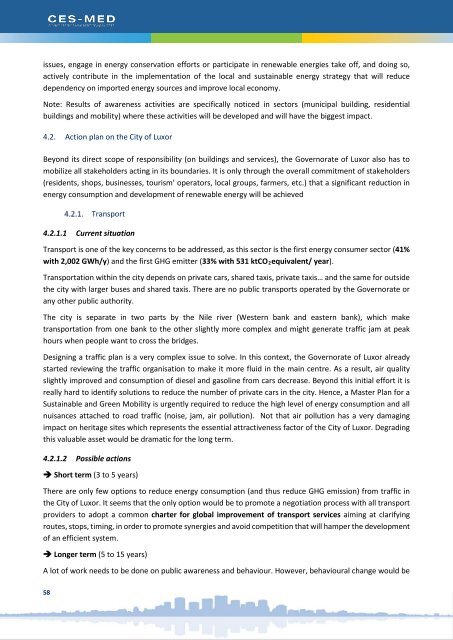280218_Luxor-Egypt SECAP Final_revised
Create successful ePaper yourself
Turn your PDF publications into a flip-book with our unique Google optimized e-Paper software.
issues, engage in energy conservation efforts or participate in renewable energies take off, and doing so,<br />
actively contribute in the implementation of the local and sustainable energy strategy that will reduce<br />
dependency on imported energy sources and improve local economy.<br />
Note: Results of awareness activities are specifically noticed in sectors (municipal building, residential<br />
buildings and mobility) where these activities will be developed and will have the biggest impact.<br />
4.2. Action plan on the City of <strong>Luxor</strong><br />
Beyond its direct scope of responsibility (on buildings and services), the Governorate of <strong>Luxor</strong> also has to<br />
mobilize all stakeholders acting in its boundaries. It is only through the overall commitment of stakeholders<br />
(residents, shops, businesses, tourism’ operators, local groups, farmers, etc.) that a significant reduction in<br />
energy consumption and development of renewable energy will be achieved<br />
Transport<br />
4.2.1.1 Current situation<br />
Transport is one of the key concerns to be addressed, as this sector is the first energy consumer sector (41%<br />
with 2,002 GWh/y) and the first GHG emitter (33% with 531 ktCO 2equivalent/ year).<br />
Transportation within the city depends on private cars, shared taxis, private taxis… and the same for outside<br />
the city with larger buses and shared taxis. There are no public transports operated by the Governorate or<br />
any other public authority.<br />
The city is separate in two parts by the Nile river (Western bank and eastern bank), which make<br />
transportation from one bank to the other slightly more complex and might generate traffic jam at peak<br />
hours when people want to cross the bridges.<br />
Designing a traffic plan is a very complex issue to solve. In this context, the Governorate of <strong>Luxor</strong> already<br />
started reviewing the traffic organisation to make it more fluid in the main centre. As a result, air quality<br />
slightly improved and consumption of diesel and gasoline from cars decrease. Beyond this initial effort it is<br />
really hard to identify solutions to reduce the number of private cars in the city. Hence, a Master Plan for a<br />
Sustainable and Green Mobility is urgently required to reduce the high level of energy consumption and all<br />
nuisances attached to road traffic (noise, jam, air pollution). Not that air pollution has a very damaging<br />
impact on heritage sites which represents the essential attractiveness factor of the City of <strong>Luxor</strong>. Degrading<br />
this valuable asset would be dramatic for the long term.<br />
4.2.1.2 Possible actions<br />
Short term (3 to 5 years)<br />
There are only few options to reduce energy consumption (and thus reduce GHG emission) from traffic in<br />
the City of <strong>Luxor</strong>. It seems that the only option would be to promote a negotiation process with all transport<br />
providers to adopt a common charter for global improvement of transport services aiming at clarifying<br />
routes, stops, timing, in order to promote synergies and avoid competition that will hamper the development<br />
of an efficient system.<br />
Longer term (5 to 15 years)<br />
A lot of work needs to be done on public awareness and behaviour. However, behavioural change would be<br />
58

















